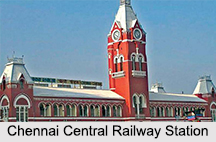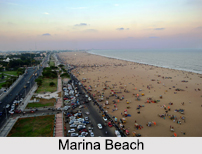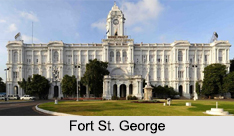Chennai City in Tamilnadu
 Located on the Coromandel Coast of the Bay of Bengal, the city of Chennai was formerly known as Madras. Standing at an average elevation of 22 feet, the highest point here is 200 feet. There are two main rivers that flow through Chennai, the Cooum River that flows through the centre and the Adyar River to the south. There is also a third river, the Kortalaiyar, which travels through the northern fringes of the city before draining into the Bay of Bengal, at Ennore. The local language spoken here is Tamil.
Located on the Coromandel Coast of the Bay of Bengal, the city of Chennai was formerly known as Madras. Standing at an average elevation of 22 feet, the highest point here is 200 feet. There are two main rivers that flow through Chennai, the Cooum River that flows through the centre and the Adyar River to the south. There is also a third river, the Kortalaiyar, which travels through the northern fringes of the city before draining into the Bay of Bengal, at Ennore. The local language spoken here is Tamil.
Etymology of Chennai
The name Chennai is of Telegu origin and was derived from the name of the Telegu ruler, Damarla Chennapa Nayakudu, who served as a general under Venakata III of the Vijayanagar Empire. It is said that the name Madras originated even before the British Rule in India. So, following the end of the British imperial rule, many Indian cities were changing their names and in the year 1996, the Government of Tamil Nadu officially changed the name from Madras to Chennai.
History of Chennai
Chennai boasts of a long history from the East India Company, through the British rule to its evolution in the late 20thcentury as an economic and educational centre in India. Established in the year 1639, the historical past of the city begins from the ancient rulers which were there in South India through colonization to the development in the 20thcentury. It was in the beginning of the 16th century, when the Portuguese arrived, that things started to change. Madras, acquired its name from Madraspattinam which is a fishing village situated to the north of Fort St. George, a fort cum trading post was built by the British between 1639-40. At that time, the weaving of cotton fabrics was a local industry, and the English invited the weavers and native merchants to settle near the fort. By 1652, the factory of Fort St. George was recognized as a presidency. The history of Chennai projects immense changes of the city during the British rule. Chennai became a prominent city, with strong naval base. With the introduction of railways in the late 19th century, Chennai got connected with other vital cities like Mumbaii and Kolkata. Facilities of trade and communication in the city advanced, connecting it with the vicinity as well. Chennai was the only city of India that was hit during the World War. After the Indian independence, Chennai city was affirmed as the capital of Madras State, which was later renamed as Tamil Nadu in 1968.
Climate of Chennai
The city of Chennai lies on the thermal equator and has a tropical wet and dry climate. Since the location of the city is along the coastline, it prevents extreme variation in seasonal temperature. The hottest months of the year is from May to June when the temperature rises to a maximum of 35 to 40° C. The month of January is the coldest when the temperature drops to a minimum of 19 to 25° C. The city gets most of its seasonal rainfall from the north-east monsoon winds between the months of October to mid-December.
Demographics of Chennai
As per the Census India reports of 2011, Chennai is the sixth largest city and the fourth most populous urban agglomeration in India. The 2011 reports further details the then population of the city to be 4,646,732 which was within the area administered by the Municipal Corporation and had 11 lakh households, with 51% of them living in rented houses. Chennai is home to a diverse population of ethno-religious communities like Telugus, Marwaris, Gujaratis, Parsis, Kannadigas, Goans, Anglo-Indians, Bengalis, Punjabis, Malayalees, etc. The city is known to have the third largest expatriate population in the country, right after Mumbai and Delhi.
Tourism in Chennai
With its historic landmarks and buildings, long sandy beaches, cultural art centres and parks, the tourism in Chennai offers many interesting locations to the visitors. In 2015, Chennai was listed as one of the most visited cities in the world standing at a rank of 43rd. The UNESCO Heritage Site of Mahabalipuram, with its ancient temples and rock carvings of the 7th century Pallava kingdom is one of the most visited places in and around Chennai. Listed below are few of the most visited places by the tourists.
Marina Beach
Located along the Bay of Bengal, the Marina Beach is the longest natural urban beach in India. It runs in a north-south direction from Fort St. George to Foreshore Estate and is a popular tourist attraction.  The beach attracts around 50,000 visitors during holidays and weekends. The Chennai Lighthouse, MGR Memorial, Anna Memorial and Jayalalitha Memorial are few of the attractions of the city. The place where the Marina ends is the beginning of another beach called Besant Nagar or the Elliot"s Beach. The iconic Karl Schmidt memorial, named after the Dutch sailor who lost his life in the process of saving others from drowning is located at the heart of Elliot`s beach.
The beach attracts around 50,000 visitors during holidays and weekends. The Chennai Lighthouse, MGR Memorial, Anna Memorial and Jayalalitha Memorial are few of the attractions of the city. The place where the Marina ends is the beginning of another beach called Besant Nagar or the Elliot"s Beach. The iconic Karl Schmidt memorial, named after the Dutch sailor who lost his life in the process of saving others from drowning is located at the heart of Elliot`s beach.
Fort St. George
Founded in 1639, the Fort St. George was built during the time of the British and is known to be a stronghold with 6 meter high walls that withstood a number of assaults in the 18th century.
 Currently, the fort houses the State Legislature and the Secretariat, the administrative complex of the Government of Tamil Nadu. The Chief Minister and the Ministers operate from here.
Currently, the fort houses the State Legislature and the Secretariat, the administrative complex of the Government of Tamil Nadu. The Chief Minister and the Ministers operate from here.
San Thome Cathedral Basilica
It is one of the three basilicas in the world built over the tomb of an apostle. It is believed that the remains of St. Thomas were buried in this area in 78 AD, on which the church was built. Since then this is popularly called as San Thome Church. Pope John Paul II visited and prayed at this tomb on 5th February 1986.
St. Thomas Mount
The St. Thomas Mount is a revenue block in the Chennai district and has sacred places like the St. Thomas Garrison Church at the foothills of the Mount, the St. Thomas Syro Malabar Catholic Church at the east side on the foot of the mountain shrine. Frequented by visitors, the mount has a shrine dedicated to Mother Mary also known as the Our Lady of Expectation was built in 1523.
Other popular attractions include the wildlife sanctuaries and eco parks like the Guindy National Park, Adyar Eco-Park, Madras Crocodile Bank Trust and the Vandalur Zoo. Temples like the Kapaleeshwarar and Parthasarathy Temple, Thousand Lights Mosque, the Armenian Church of Virgin Mary and the St. Mary"s Church are often visited by tourists. Other than these, the open air museum of Dakshina Chitra, then the art and cultural academy of Kalakshetra and the Cholamandalam Artists" Village, which is the largest artists" commune in India, are also quite prominent in the city.
Chennai hosts a magnum opus cultural event, the annual Madras Music Season, where hundreds of artists perform. The city owns a pulsating theatrical scene and is a key centre for the classical dance form, Bharatnatyam. The thriving Tamil film industry, known as Kollywood, is based in the city. Chennai is known for its sports venues and hosts an Association of Tennis Professionals (ATP) event, the Chennai Open.
Visiting Information on Chennai
The city has its own means of air transport in the form of the Chennai International Airport, which is known to be the fourth busiest airport in India in terms of passenger traffic. Chennai hosts the headquarters of the Southern Railway and has 4 main railway terminals- Chennai Central, Chennai Egmore, Chennai Beach and Tambaram. The Chennai Metro was planned and approved by the state cabinet during 2007 for which construction began on 2009. And via roadways, Chennai is one of the cities in India that is connected by the Golden Quadrilateral system of the National Highway. The city is also served by two major sea ports, the Chennai Port, one of the largest artificial ports in India, and the Ennore Port.
Discover local businesses including manufacturers,
suppliers, and dealers across industries in Chennai Yellowpages.



















